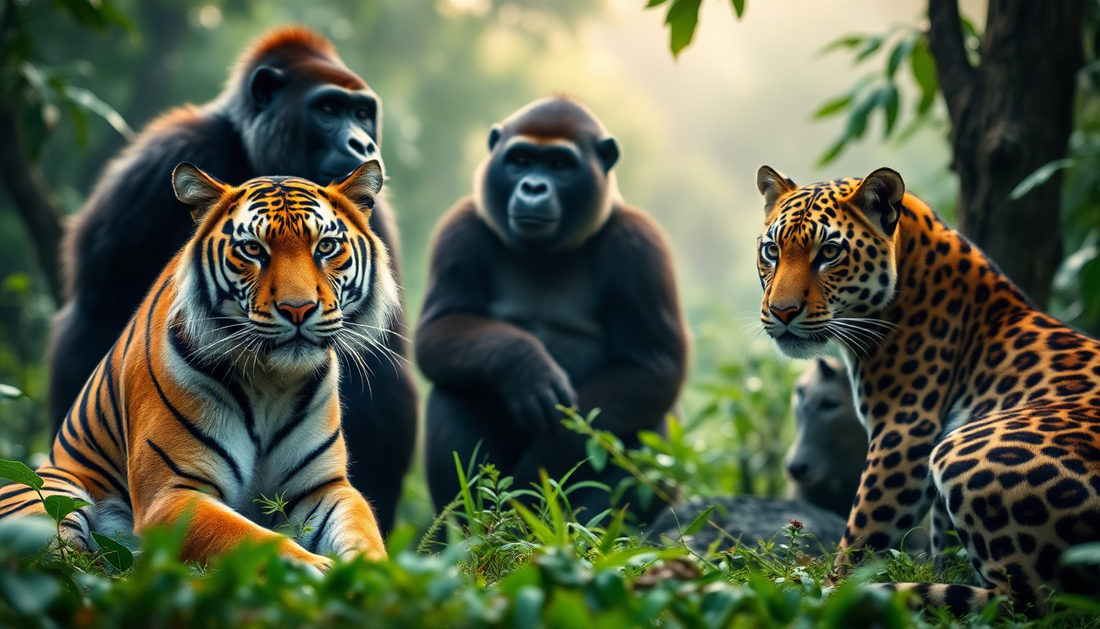In a world where human activities have profoundly impacted the natural environment, the plight of endangered wildlife has become a pressing global concern. As we grapple with the alarming rates of species extinction, it is our collective responsibility to take decisive action to protect and preserve the delicate balance of our planet's ecosystems.
The Global Biodiversity Crisis
The Earth is currently facing an unprecedented biodiversity crisis, with species disappearing at a rate that far exceeds the natural pace of extinction. According to the International Union for Conservation of Nature (IUCN), over 28,000 species are currently threatened with extinction, a staggering figure that underscores the gravity of the situation. From majestic mammals to delicate avian species, the diversity of life that has evolved over millions of years is now under threat, a consequence of human-driven activities that have disrupted the natural order.
Understanding Endangered Species
An endangered species is defined as a species that is at risk of extinction in the wild, facing a high probability of disappearing from its natural habitat in the near future. The IUCN Red List of Threatened Species, the most comprehensive inventory of the global conservation status of biological species, categorizes endangered species into various levels of risk, including Critically Endangered, Endangered, and Vulnerable.
Major Threats to Wildlife
The primary threats to endangered wildlife are multifaceted, stemming from human activities that have profoundly altered the natural world. Habitat destruction, driven by factors such as deforestation, urbanization, and agricultural expansion, is a leading cause of species decline, as animals are deprived of their natural homes and resources. Climate change, a global phenomenon exacerbated by human-induced greenhouse gas emissions, is also taking a toll on wildlife, disrupting delicate ecosystems and forcing species to adapt to rapidly changing environmental conditions.
Poaching and the illegal wildlife trade pose another grave threat, as high-demand for exotic animals and their body parts fuels a lucrative black market that decimates populations. Additionally, human-wildlife conflict, arising from the encroachment of human settlements into natural habitats, can lead to the persecution and displacement of wild animals.
Endangered Animal Case Studies
To illustrate the plight of endangered species, let us examine a few specific examples:
Mammals
The African elephant, once roaming the savannas and forests in vast numbers, is now classified as Vulnerable, with its population declining due to poaching and habitat loss. The Sumatran tiger, a subspecies found only in the Indonesian island of Sumatra, is Critically Endangered, with fewer than 400 individuals remaining in the wild.
Birds
The Kakapo, a flightless parrot endemic to New Zealand, is one of the world's rarest birds, with only around 200 individuals left. The Spix's Macaw, a vibrant blue parrot native to Brazil, is Critically Endangered and believed to be functionally extinct in the wild.
Reptiles
The Galápagos tortoise, a symbol of the Galápagos Islands, is classified as Vulnerable, threatened by invasive species, disease, and human activities. The Hawksbill sea turtle, renowned for its distinctive shell, is Critically Endangered due to the illegal trade in its shell and the destruction of its nesting habitats.
Marine Species
The vaquita, a small porpoise found in the Gulf of California, is the world's most endangered marine mammal, with fewer than 20 individuals remaining due to bycatch in illegal fishing nets. The Coral reefs, the "rainforests of the sea," are also under threat, with climate change and ocean acidification causing widespread bleaching and degradation.
Conservation Strategies
Safeguarding endangered wildlife requires a multifaceted approach, involving a combination of international cooperation, national policies, and community-based initiatives. Protected area management, such as the establishment of national parks and wildlife refuges, is a crucial strategy for preserving habitats and providing safe havens for threatened species.
International wildlife protection agreements, such as the Convention on International Trade in Endangered Species of Wild Fauna and Flora (CITES), have been instrumental in regulating the global trade in endangered species and their derivatives. Breeding and reintroduction programs, as well as community-based conservation initiatives that empower local communities to protect their natural resources, have also proven effective in species recovery efforts.
Individual and Collective Action
While governments and conservation organizations play a vital role in protecting endangered wildlife, individual actions can also make a significant impact. Adopting sustainable lifestyle choices, such as reducing our carbon footprint, avoiding the consumption of wildlife products, and supporting eco-friendly businesses, can contribute to the preservation of endangered species and their habitats.
Furthermore, actively supporting conservation organizations, both financially and through volunteer work, can amplify our collective efforts to safeguard the natural world. By raising awareness, advocating for policy changes, and participating in conservation initiatives, we can all become stewards of the planet, ensuring a future where endangered species can thrive.
The Future of Wildlife Protection
As we look to the future, technological innovations and advancements in scientific research hold promise for more effective wildlife conservation. From the use of drones and satellite imagery to monitor and protect habitats, to the development of innovative solutions to mitigate human-wildlife conflict, the integration of technology and conservation efforts can enhance our ability to safeguard endangered species.
Additionally, strengthening international cooperation and implementing robust policies that prioritize environmental protection are crucial for the long-term preservation of biodiversity. By working together across borders and sectors, we can develop comprehensive strategies to address the multifaceted challenges facing endangered wildlife.
Conclusion
The plight of endangered wildlife is a global crisis that demands our immediate attention and collective action. By understanding the threats, supporting conservation efforts, and making sustainable lifestyle choices, we can all play a role in preserving the rich tapestry of life that makes our planet so unique and precious.
The time to act is now. Let us heed the call to action and work tirelessly to safeguard our planet's endangered wildlife, ensuring that future generations can marvel at the wonders of the natural world and the resilience of its inhabitants. Together, we can create a future where biodiversity thrives, and our shared home remains a vibrant, life-sustaining haven for all.

